中职英语基础模块上册unit1
- 格式:pptx
- 大小:9.59 MB
- 文档页数:70

“外研版”中职国规英语教材基础模块(修订版)第一册Unit 1 School becomes interesting.一、单元整体解读及分析二、分课时教学设计第1课时2. 匹配教师展示学校平面图。
通过提问,请学生将课程与上课地点匹配。
1) Where do we have these classes?2) All these classes below are called subjects. The classes in labs are called2. 模拟对话3. 自主对话第2课时2. 词汇学习播放听力(第一遍)Read and fill in the form.第3课时2. 学生展示作业1.阅读Read and learn2)连句成段表述Match the words with the pictures.第4课时2.阅读课文,回答问题1) Why did Schulman attend avocational school?2) When is the Speech Day?2.绕口令教师要求学生练习绕口令。
1) Silly sheep weep and sleep.2) I wish you were a fish in my dish.作者简介:沈碧红,中共党员,中学一级。
从教十年,一直坚守在中职英语教育第一线。
曾获得“外研社杯”全国中职英语教师基本功比赛一等奖和教学设计二等奖,慈溪市“青年骨干教师”和“教坛新秀”荣誉称号。
辅导学生参加各类英语类竞赛获得全国二等奖,浙江省一二三等奖。
系浙江省与宁波市优秀指导教师和慈溪市“五四奖章”获得者。
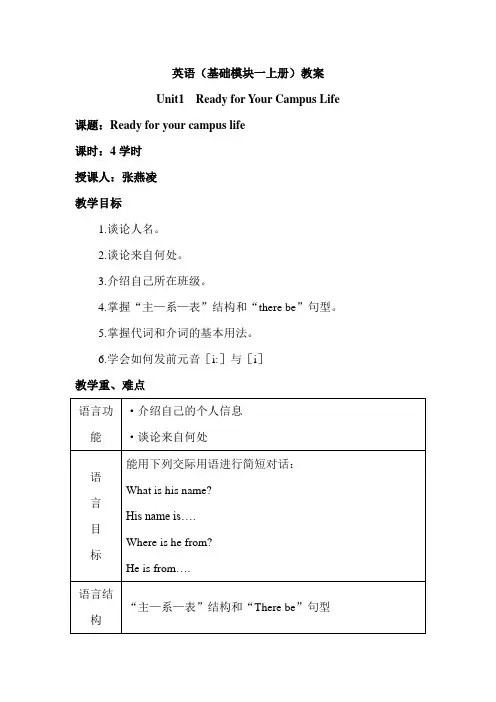
英语(基础模块一上册)教案Unit1 Ready for Your Campus Life 课题:Ready for your campus life课时:4学时授课人:张燕凌教学目标1.谈论人名。
2.谈论来自何处。
3.介绍自己所在班级。
4.掌握“主—系—表”结构和“there be”句型。
5.掌握代词和介词的基本用法。
6.学会如何发前元音[i:]与[i]教学重、难点教学方法:讲解法、分析法、提问法、讨论法教学过程:(一)Warm-up1.老师首先用英语向全班学生作自我介绍,并提出新学习阶段的英语学习要求。
例如:Hello, everyone. My name is…. I’m your English teacher this year. Let’s do our best together to improve our Learning of English. Now at the beginning of this term, I would like to advise you to plan your time carefully. Be sure to have enough time to recite the new words and useful expression, to listen to enough English tapes, to read many English articles, to do oral practice as much as possible and to finish your homework on time.Second, I advise you to make good use of your time in class. Listening carefully in class really means less work later. Taking notes will help to remind you what the teacher said.Another important suggestion is that you should develop a good attitude towards your English reading, listening, speaking and writing. Don’t be afraid of making mistakes when you are speaking English. Just try your best to say what you want in English every time.I’ll do my best to help you and I hope everyone will get a greatprogress in the shortest possible time ….此外,还可以设计一些常用口令、手势、规定一些纪律,以便在以后的教学中,形成良好的习惯,达成默契。
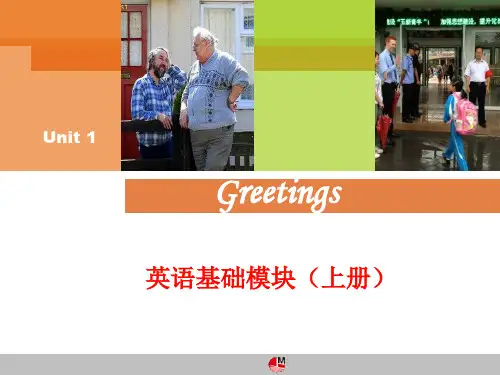

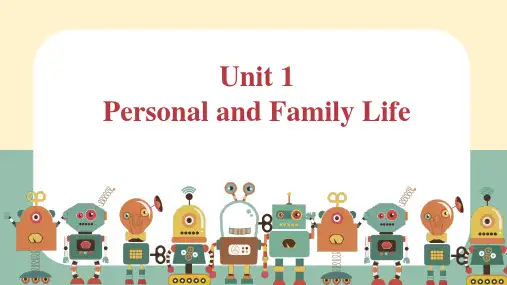
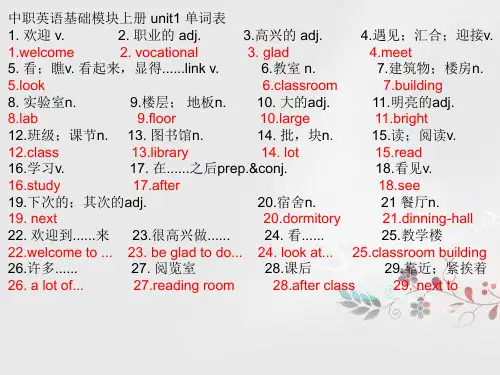

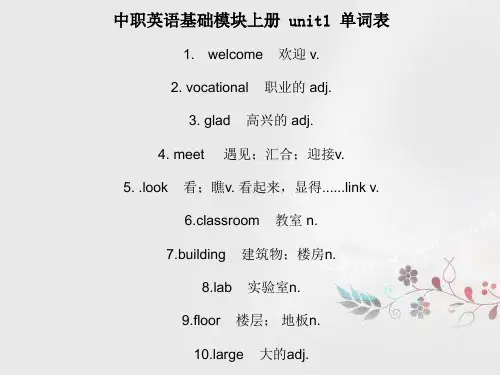
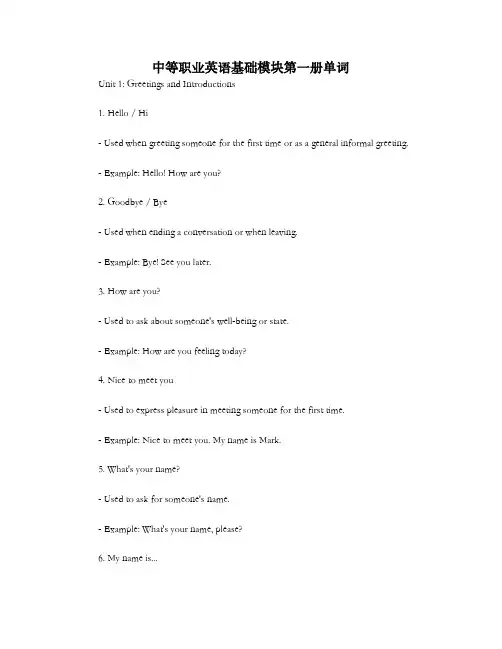
中等职业英语基础模块第一册单词Unit 1: Greetings and Introductions1. Hello / Hi- Used when greeting someone for the first time or as a general informal greeting. - Example: Hello! How are you?2. Goodbye / Bye- Used when ending a conversation or when leaving.- Example: Bye! See you later.3. How are you?- Used to ask about someone's well-being or state.- Example: How are you feeling today?4. Nice to meet you- Used to express pleasure in meeting someone for the first time.- Example: Nice to meet you. My name is Mark.5. What's your name?- Used to ask for someone's name.- Example: What's your name, please?6. My name is...- Used to introduce oneself and provide the name.- Example: My name is Emily. Nice to meet you.7. Where are you from?- Used to ask about someone's place of origin.- Example: Where are you from originally?8. I'm from...- Used to state one's place of origin.- Example: I'm from France. What about you?9. How old are you?- Used to ask about someone's age.- Example: May I ask how old you are?10. I'm... years old.- Used to state one's age.- Example: I'm 25 years old. How about you?Unit 2: Numbers1. Zero- The numerical symbol representing the value of nothing or no quantity. - Example: There are zero seats available.- The numerical symbol representing the value of a single unit or entity. - Example: I have one sister.3. Two- The numerical symbol representing the value of two units or entities. - Example: I need two cups of coffee.4. Three- The numerical symbol representing the value of three units or entities. - Example: I have three cats.5. Four- The numerical symbol representing the value of four units or entities. - Example: There are four chairs in the room.6. Five- The numerical symbol representing the value of five units or entities. - Example: I have five fingers on each hand.7. Six- The numerical symbol representing the value of six units or entities. - Example: She has six books on her shelf.- The numerical symbol representing the value of seven units or entities. - Example: We'll meet at seven o'clock.9. Eight- The numerical symbol representing the value of eight units or entities. - Example: I'll be there in eight minutes.10. Nine- The numerical symbol representing the value of nine units or entities. - Example: There are nine planets in our solar system.Unit 3: Colors1. Red- The color associated with passion, love, and intensity.- Example: She was wearing a stunning red dress.2. Blue- The color associated with calmness, serenity, and stability.- Example: The sky is a beautiful shade of blue today.3. Yellow- The color associated with happiness, joy, and energy.- Example: The sunflowers are bright yellow.4. Green- The color associated with nature, growth, and freshness.- Example: The leaves on the trees are a vibrant green.5. Orange- The color associated with enthusiasm, creativity, and warmth. - Example: He painted the walls in a lovely shade of orange. 6. Purple- The color associated with royalty, luxury, and power.- Example: The queen wore a regal purple gown.7. Pink- The color associated with femininity, sweetness, and kindness. - Example: The baby girl's room is painted in soft pink.8. Brown- The color associated with earthiness, stability, and reliability. - Example: His eyes are a warm shade of brown.9. Black- The color associated with formality, elegance, and mystery.- Example: She wore a black evening gown to the party.10. White- The color associated with purity, innocence, and cleanliness.- Example: The bride wore a white wedding dress.This document provides a comprehensive list of basic words related to the Middle Vocational English Module 1. The topics covered include greetings and introductions, numbers, and colors. Each unit contains ten words, along with brief explanations and examples. These words will help you build a solid foundation in the English language.。
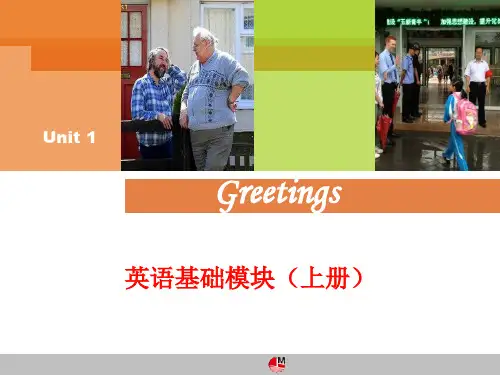
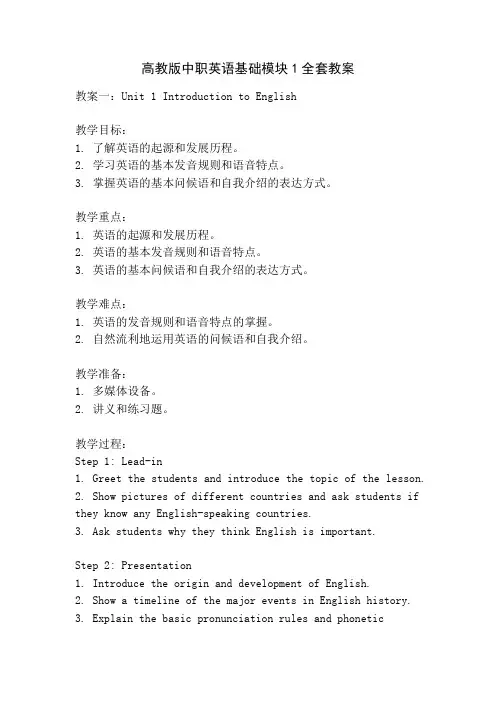
高教版中职英语基础模块1全套教案教案一:Unit 1 Introduction to English教学目标:1. 了解英语的起源和发展历程。
2. 学习英语的基本发音规则和语音特点。
3. 掌握英语的基本问候语和自我介绍的表达方式。
教学重点:1. 英语的起源和发展历程。
2. 英语的基本发音规则和语音特点。
3. 英语的基本问候语和自我介绍的表达方式。
教学难点:1. 英语的发音规则和语音特点的掌握。
2. 自然流利地运用英语的问候语和自我介绍。
教学准备:1. 多媒体设备。
2. 讲义和练习题。
教学过程:Step 1: Lead-in1. Greet the students and introduce the topic of the lesson.2. Show pictures of different countries and ask students if they know any English-speaking countries.3. Ask students why they think English is important.Step 2: Presentation1. Introduce the origin and development of English.2. Show a timeline of the major events in English history.3. Explain the basic pronunciation rules and phoneticfeatures of English.4. Use audio or video materials to demonstrate the correct pronunciation.Step 3: Practice1. Divide the class into pairs or small groups.2. Give students a list of common greetings and ask them to practice using them in different situations.3. Have students practice introducing themselves to each other using the phrases and sentences learned.Step 4: Consolidation1. Review the key points of the lesson, including theorigin and development of English, pronunciation rules, and greetings.2. Ask students to summarize what they have learned intheir own words.Step 5: Assessment1. Give students a short quiz to test their understanding of the lesson.2. Assign homework, such as writing a short paragraph about the importance of English or practicing greetings and self-introductions.教案二:Unit 2 Numbers and Time教学目标:1. 学习基本的数字和时间表达方式。
中职英语基础模块1单词表Unit 1 Greetings.1. hello [həˈləʊ] int. 喂;你好(表示问候等)2. hi [haɪ] int. 嗨;你好(非正式问候语)3. good [ɡʊd] adj. 好的;令人满意的。
4. morning [ˈmɔːnɪŋ] n. 早晨;上午。
5. afternoon [ˌɑːftəˈnuːn] n. 下午。
6. evening [ˈiːvnɪŋ] n. 晚上;傍晚。
7. how [haʊ] adv. 怎样;如何;多么。
8. are [ɑː(r)] v. 是(be的第二人称单复数现在式)9. you [juː] pron. 你;你们。
10. fine [faɪn] adj. 健康的;美好的。
11. thanks [θæŋks] n. 谢谢;感谢 int. 谢谢。
12. OK [əʊˈkeɪ] adj. 好的;不错的 int. 行;可以。
Unit 2 Introduction.1. name [neɪm] n. 名字;名称。
2. nice [naɪs] adj. 令人愉快的;美好的。
3. to [tuː] prep. 到;向;(表示接受动作的人或物)给。
4. meet [miːt] v. 遇见;相逢;结识。
5. too [tuː] adv. 也;又;太。
6. his [hɪz] pron. 他的。
7. her [hɜː(r)] pron. 她的。
8. your [jɔː(r)] pron. 你的;你们的。
Unit 3 Family.1. family [ˈfæməli] n. 家庭;家族。
2. father [ˈfɑːðə(r)] n. 父亲;爸爸。
3. mother [ˈmʌðə(r)] n. 母亲;妈妈。
4. parent [ˈpeərənt] n. 父(母)亲。
5. brother [ˈbrʌðə(r)] n. 兄弟。